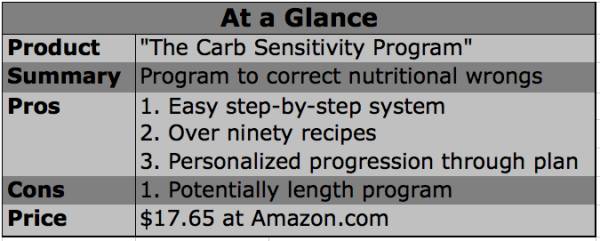
Though you’re reading these words because I am, in part, a writer for Breaking Muscle, much of my time is consumed as a coach and a passionate advocate for real food nutrition. In addition to coaching fitness, I even created a sports nutrition company, ORIGINAL Nutritionals, based on my passion for a responsible, real food lifestyle. Why am I telling you this? I’m telling you this because when I came across The Carb Sensitivity Program by Dr. Natasha Turner, I was curious as to which side of my very tall fence this book would fall.
In my time with the book, I was able to read about the program as a passionate, knowledgeable observer. I also took time to interview Dr. Turner for yet a deeper understanding both in the intentions of the book and the outcomes it has yielded since the last pages were printed. Coming in as a skeptic, I set the book down feeling like I had another confidant fighting the good fight with me toward a healthier, one meal at a time.
 The Carb Sensitivity Program (CSP) sets out to address an out of control health issue rooted in insulin abuse. CSP is Dr. Turner’s third book, and it stands on a solid foundation created by her first two books, The Hormone Diet and The Super Charged Hormone Diet. These two books pave the way for a hormonal based nutritional strategy.
The Carb Sensitivity Program (CSP) sets out to address an out of control health issue rooted in insulin abuse. CSP is Dr. Turner’s third book, and it stands on a solid foundation created by her first two books, The Hormone Diet and The Super Charged Hormone Diet. These two books pave the way for a hormonal based nutritional strategy.
The hormonal insulin response triggered by carbohydrate consumption is often recognized as the guilty culprit behind obesity, heart disease, and many other modern ailments. This text seeks to wean its participants off of their respective carbohydrate sensitive diets and systematically reintroduce carbohydrates in a fashion that doesn’t yield health consequences manifested on blood work panels, or their waistline.
Dr. Turner’s text begins with context for readers who are in the dark about what psychological functions contribute to fat storage. In addition, Dr. Turner paints a clear picture that on some level all carbohydrates promote an insulin response. Given current lifestyle habits and nutritional strategies, many of us are on the verge of insulin resistance, which means when we consume a sweet potato our bodies may respond no different than if we’d had a bowl of sugar.
With a dismal but informative understanding of the state of much of the population’s nutritional situation, Dr. Turner directs her readers to the actual program, which does much more than explain the “whys” of obesity. The program addresses many of the “hows” with regards to digging our way out of a potentially deep carbohydrate sensitive, insulin resistant hole.
Dr. Turner walks men and women through a step-by-step process of gradual reintroduction of carbohydrates with constant evaluation of markers that indicate a spike in sensitivity, such as insulin response and weight gain. The first of six stages, for example, is the most restricted with regards to carbohydrate consumption. It excludes nearly all starchy vegetables, with a focus on lean meats, good fats, and some fruits and vegetables. Each step of the way, participants are asked to answer a checklist of questions. If the carbohydrate load of any particular stage is without negative effects, then they are free to move to the next, more carbohydrate liberal phase. All the while, people are resetting their insulin receptors to potentially handle carbohydrates in a healthy manner again.
As a curious devil’s advocate, I asked Dr. Turner what the goal of the program was. Is it to systematically create an opportunity for the ultimate omnivore to consume nearly all foods in a controlled manner, free of major health consequences? Why move past Phase I or Phase II and even dance with the devil with higher glycemic carbohydrates? My concern with this system was that it would work in the sense that folks would earn some normalization in insulin function, but as they progressed down the line towards a nearly open table of carbohydrate consumption they could eventually undermine their newfound success. If there were no goal to keep grains and other higher glycemic carbohydrates in the diet, wouldn’t the CSP be fool proof if folks never moved beyond the more rigid first phases?
In many ways, Dr. Turner agreed with me. As she explained to me, “I agree. You know, the majority of people usually start getting into sensitivities around stage four, when you start to put in grains. You’ve got to have a healthy metabolism to get to the last phase.”
The CSP, of course, is a tool to repair metabolic derangement. As you begin to work your way through these gateways of carbohydrate reintroduction, you may be wondering what happens if you reach a level in which carbohydrates begin to have a negative effect. The CSP doesn’t leave folks in the dust by any means. The program will spit you out into a Metabolic Repair program, advising you to use proper nutrition, some supplementation, and even a training protocol to right your metabolic wrongs.
The CSP includes some ninety easy-to-follow recipes. As a coach myself, I understand the value of having clear instructions for participants. The CSP leaves no room for wonder and keeps its readers fully aware of tools to use and knowledge about their respective “next step.”
Who is the CSP for? When I asked Dr. Turner, she said that it’s obvious the most metabolically deranged folks, obese individuals, and the least healthy people may see the most progress, but the CSP is relevant for nearly all of us. If not now, we will likely need some insight into our sensitivities of carbohydrates in the future. As Dr. Turner noted, as we grow older we lose muscle mass, and naturally become more insulin dominant.
Overall I was pleased with how thorough this book was. Dr. Turner builds enough context to get you motivated and she delivers a clear and detailed plan to guarantee success in the program. The only question is whether or not folks are willing to hang on throughout the program, or not.
“The Carb Sensitivity Program” is available on Amazon.com for $17.65.






